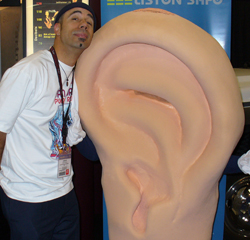
Taking Care
If a musician chooses to purchase IEM, an experienced audiologist should “shoot” the ear molds for the end-user. Responsible audiologists should make themselves available to attend either a rehearsal and/or a soundcheck where they can take “probe microphone measurements”.
By placing a small microphone in the ear canal, an audiologist can take a measure of how loud (in dB SPL) the user “wears” their IEM. This information makes it possible for the audiologist to counsel the user on a preferred range of loudness to monitor at during performances, which should help minimize the risk of hearing loss.
In addition to careful fitting and the measuring of loudness levels, music and audio professional should have their hearing professionally tested at least once a year. If possible, it would be ideal to find an audiologist who can perform “high-frequency audiometry”.
By industry standards, audiologists typically test up to only 8 kHz, but some audiologists have the specialized equipment necessary to test up to 18 kHz or 20 kHz. Although there are no established “normal” criterion for high frequency audiometry, serial test results my be compared over time, which may be a useful clinical indicator of early hearing loss in the long run.
Regular recordings of “otoacoustic emissions” may also provide evidence of sub-clinical hearing loss (damage to the cochlea that is seen before it effects you to the point where there is an audiometric decrease in hearing thresholds).
When used cautiously, IEM may offer a dramatic range of improvements for the professional audio engineer or touring musician. Appropriate use may also serve to protect your most valuable and irreplaceable instrument; your ears.
Hearing Note 1:
Using an IEM system does not guarantee hearing protection! Some IEM rigs are capable of producing levels in excess of 130 dB SPL. Prolonged exposure to these kinds of levels will likely cause hearing loss. It is up to each user to be responsible for protecting his/her hearing.
Hearing Note 2:
Tinnitus (head noise) is a common occurrence and occurs in many forms. It can be intermittent or constant, mild or severe, and vary from a low roar to a high-pitched type of sound. It also may be subjective (audible only to the patient) or objective (audible to others). Further, it may or may not be associated with hearing impairment.
Tinnitus must always be thought of as a symptom and not a disease. Because the function of the auditory (hearing) nerve is to carry sound, when it is irritated from any cause, the brain can interpret the impulse as noise. (Courtesy of House Ear Institute)
Limiting Your Exposure:
The National Institute for Occupational Safety and Health (NIOSH) guidelines are stated in terms of the maximum time that you can safely be exposed to different time-weighted averages (TWAs) of sound pressure on a daily basis over a 40-year period.
TWA dB Levels, Maximum Exposure Time:
85 dB: 8 hours
88 dB: 4 hours
91 dB: 2 hours
94 dB: 1 hour
97 dB: 30 minutes
100 dB: 15 minutes
103 dB: 7-1/2 minutes
106 dB: 3-3/4 minutes
Exposure to 115 dB or greater may pose a serious health risk.
Rachel Cruz holds a Bachelors degree in Music Production and Engineering from Berklee College of Music and a Masters degree in Audiology and Hearing Sciences from Northwestern University and served as a research associate at the House Ear Institute in the Department of Auditory Implants and Perception.
